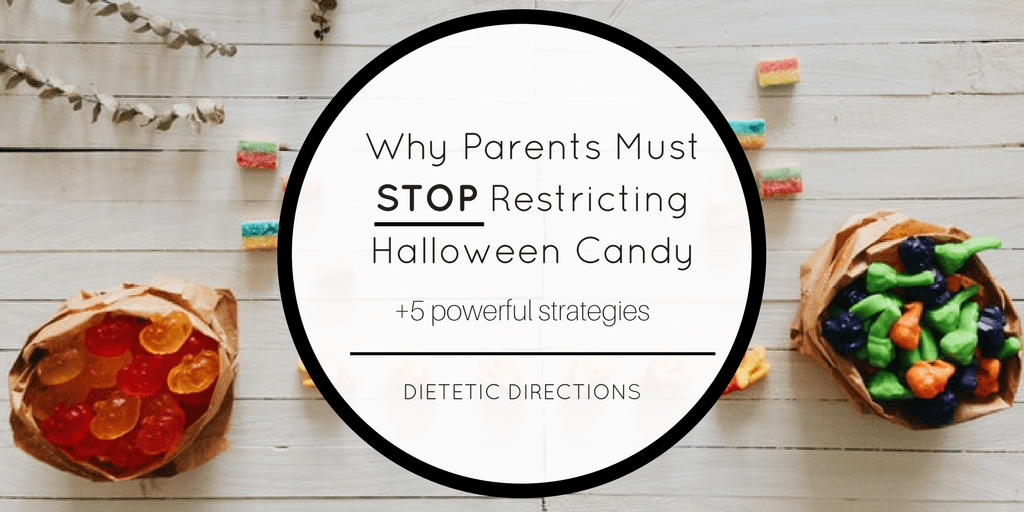
Why Parents Must STOP Restricting Halloween Candy
Halloween is fast approaching. This means Halloween candy is in abundance or it will be when the ‘Trick-or-Treaters’ come knocking! In my dietitian practice, many parents worry about their child’s candy intake. How much is too much? What if they over-consume, become candy-obsessed and their teeth rot out of their little heads? These concerns lead many (well-intentioned) parents to start restricting or ‘policing’ treats.
In honour of Halloween, I will highlight why parents must STOP restricting Halloween Candy. The intention of this article is not to blame, but to underscore the importance of eating strategies that build an intuitive eater who is much less likely to binge. An intuitive eating child is confident listening to his/her body and has a positive relationship with (all types) of food.
The Dangers of Halloween Candy Restriction
Research studies found that restricting candy (or highly palatable foods) causes children to actually eat MORE when it becomes available (here, here, here). According to a 2000 study, restricting the children increased their preference for and intake of these foods. This study involved eleven-year old girls who first ate a standard lunch followed by free access to snacks. The restricted individuals ate more snack foods and felt negatively about their eating.
Additionally, research found a relationship between parental restriction, child weights as well as poor eating habits. Additionally, studies have found food/candy restriction predicts “eating in the absence of hunger” (here, here, here). Eating in the absence of hunger is also correlated to higher weights. The rationale is that when food is restricted, humans mainly respond to external cues (ie. availability of food). After all, if we feel restricted, we naturally want to eat when food’s available (whether we’re hungry or not!). If treats weren’t restricted, children could listen to their “internal” body cues to decide whether they wanted treats (and how many).
Research shows restricting candy = kids eat MORE! Share on XThe “Forbidden Fruit” Theory:
Before getting into my child candy strategies, let’s first state the obvious. Forbidden fruit always tastes sweeter. Doesn’t it?! If a child (or an adult) is told not to do something, it suddenly becomes much more alluring, mysterious, or even a challenge! We naturally want to find things out for ourselves.
For example, imagine I told you to NEVER eat/drink something you enjoy (i.e., wine/chocolate ice cream/sour cream chips, etc). What would you suddenly crave? Even individuals who enjoy this certain treat occasionally will fixate on the restrictions. I know if I was told I could never eat chocolate ice cream again (which I don’t often eat), I would without a doubt start seeking it IMMEDIATELY! That’s the power of forbidden fruit, it makes people want it more. Instead, there are strategies parents can use to not vilify foods and help teach moderation and listening to the body.
Check out Dietetic Directions' Top 5 Tips 2 Avoid Restricting Candy! Share on XAndrea’s 5 Powerful ‘Non-Restricting’ Strategies:
1. Create a Positive Structured Food Environment
Naturally, our eating environment shapes our feelings toward foods and our eating habits. Therefore, when encouraging candy moderation, parents need to first provide a positive environment for children to learn about (all types of) food and how it makes the body feel.
A child’s eating environment shapes their feelings toward foods & eating habits Share on XA positive food environment means that people do not use food as a reward or punishment. This controlling/coercive approach has the opposite effect. For example, your child may feel forced to eat their green peas in order to have dessert, this serves to create negative feelings and they’ll be less likely to ever enjoy peas. This also makes the child more drawn to eat dessert/treats, which they equated with a “reward.”
Children thrive in structured food environments. I highly recommend offering three (nutritionally balanced) meals at pre-determined times. This regulates your child’s appetite and builds confidence that they will not be hungry. Parents may also offer snacks between meals (of pre-determined foods and also at pre-determined times).
2. Allow Food Freedom!
To help children learn moderation, parents must ALLOW “Food Freedom” to choose the amount of candy they want to eat. Do this within the above meal structures. For example, when coming home from ‘Trick-or-Treating’, spread candy on the table and allow your child to eat from what is being offered. Encourage them to eat until they feel satisfied. If you are shocked that a dietitian is saying this please read on.
By allowing children to eat the amounts that they desire (without restriction) we are granting that child autonomy and permission to decide how much they want to eat. Remember that children are naturally intuitive eaters – they will eat when they are hungry and stop when they are full. When parents encourage children to listen to their bodies, the child discovers how much they need to eat. Conversely, when parents dictate how much the child ‘should’ eat, we slowly erode the intuitive eating skill.
Granting your child ‘Food Freedom’ to eat however much they want (in addition to nutritionally balanced meals), takes away the “feast or famine” mentality which leads to over-consumption.
3. Encourage Mindful Eating
As you can tell from my liberal candy stance, it is important to remain neutral with treats – refrain from demonizing candy or fear mongering. The more negative food feelings, the more “shouldn’t” internalized, the greater the binge tendencies. Instead, let your child know there’s nothing wrong with enjoying Halloween candy. This liberates your child to take pleasure when eating.

Parents can teach mindful eating by making it a full sensory experience. Ask questions like:
- What treat would you like? (Allow them to choose from what is being offered).
- Encourage them to take a bite.
- “What’s the taste like?” “What’s the smell like?” “How would you describe the texture?”
- Would you like another? Same mindfulness questions. Could also ask “How does that treat compare to the previous one?” “Which treat do you prefer and why?”
By asking mindfulness questions, parents keep the eating experience positive (which decreases binging tendencies). Mindfulness slows eating and helps us to tune into our bodies
4. When Should Treats be Offered?
As previously mentioned, as a parent, you are responsible to setting structure around the frequency and availability of all types of foods. Allowing your child to eat candy does not mean that candy is always readily available. Instead, store candy out of view and offer only at set times. Keeping highly palatable foods in sight, but off limits reinforces the feeling of restriction and corresponding over-eating tendencies.
A common pitfall is when parents try to control “how much” children eat. Instead according to child feeding expert, Ellyn Satter, parents need to focus on “when the food/candy is offered”. Let the child decide how much. Give your child freedom to listen to his or her body. Research mentioned above shows that restricting increases preference towards these foods and decreases self-control to stop eating the restricted foods.
Parents often ask me when they can offer their child sweets. I recommend after a nutritionally balanced meal. This allows your child to fill up on nourishing foods. Kids can then have a treat (or treats) afterwards. Encourage your children with the above tips to eat until they are full and listen to their bodies with mindfulness.
5. Tackle YOUR Eating Issue!
What kids pick up is amazing. Parents who have a difficult time moderating their intake are more likely to have children who also have a difficult time moderating their intake. Many clients are working with one of our dietitians for emotional eating. Parents may have to take a closer at their own “food rules” and relationship with food in order to be a positive role model for their children.
DYK: Your relationship with food will likely be passed on to your child. Share on XParents also need to lift food restriction and allow themselves to fully experience and enjoy foods or treats. When we allow ourselves to experience (any type of) food –without deprivation- only then can we can feel fully satisfied. Living with eating shame leads to overeating because we never feel satisfied. However, if we learn how to ALLOW ourselves to enjoy and be fully present the overeating tendency can subside. You can practice these food relationship strategies with a dietitian or therapist who specializes in intuitive eating and transforming your relationship with food.
Bottom Line on Restricting Halloween Candy:
Parents, please do not restrict Halloween candy! Allow and normalize Halloween candy in order to promote moderation, help children learn self-regulation and form a positive relationship with food. The research shows that restricting or policing increases desire and consumption of the very foods you’re trying to restrict.
Let’s all enjoy some halloween candy! Lift the negativity, fear mongering and not-so-sweet worries. Trust that your child will eat when they are hungry and stop when they are full. Set the stage by offering regular nutritionally balanced meals, snacks as needed and treats kept out of view. When candy and treats are normalized and allowed, children have the freedom to listen to their bodies and enjoy their food.
Now it’s your turn! How do you feel about policing Halloween candy? As a child, what did you experience?











